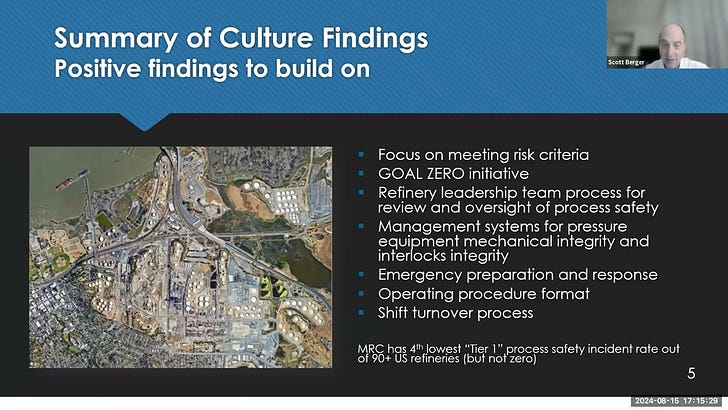Safety Culture Assessment Outlines Areas for Improvement at PBF Energy's Martinez Refinery
Independent investigation finds that while MRC performs well in a number of key safety categories, the refinery can do a better job in others; public has until Sept. 16 to comment
This article by freelance writer Tom Lochner is made possible through the financial support of paid subscribers and other financial donors to the newsletter. It is being made available in full to paid subscribers only. Please consider becoming a paid subscriber if not already for $5 a month or $50 annually to support more local coverage of Martinez.
By Tom Lochner
A consultant's report on the safety culture at PBF Energy's Martinez Refining Co., prompted by a series of refinery mishaps that started with the Thanksgiving 2022 spent catalyst release, features a mix of criticisms and compliments.
At an Aug. 15 public meeting hosted by Contra Costa Health’s Hazardous Materials Programs, Scott Berger of Scott Berger and Associates, LLC, assisted by Kenan Stevick of KVS Process Safety LLC, presented a PowerPoint summary of the "Independent Safety Culture Assessment of PBF Energy Martinez Refinery" related to the 2022 hazardous materials release, Version 2 of which was published on July 5.
The hazmat release on the night of Nov. 24-25, 2022, spread about 24 tons of toxic metal-laden dust on parts of Martinez and surrounding communities. It was the first in a yearlong series of mishaps at the refinery that led county officials to request an independent assessment of MRC’s safety culture.
The 45-day public comment period for the report will end on Sept. 16. Comments can be sent via email to hazmat.arpteam@cchealth.org or by regular mail to Contra Costa Health Hazardous Materials Programs, Attn: Michael Dossey, 4585 Pacheco Blvd., Ste. 100, Martinez CA 94553.
The safety culture assessment is "a snapshot in time" — March of this year, Berger said. "Since that time, MRC's culture probably has changed, hopefully for the better."
The Aug. 15 PowerPoint led off with a "summary of culture findings," during which Berger singled out four key improvement opportunities, starting with "shortcomings in the way MRC investigated past incidents." Stevick elaborated on those opportunities later in the presentation.
The second involves problems with consistency in the way procedures are followed, in particular when manual controls are used instead of automatic controls.
(A "root cause analysis" of the Thanksgiving 2022 release, conducted earlier this year also by Berger and Associates, found that a key cause was that a key piece of equipment called stripper slide valve, designed to regulate the flow of catalyst, was left in manual mode instead of being placed in automatic mode).
Third, Berger noted there are "very good aspects of MRC's reliability program" that need to be applied to other sectors as well.
The fourth addresses the adequacy of the "sense of urgency" at MRC; Berger noted that action items resulting from process safety audits that required rapid response had "overly long 'complete-by' dates."
Berger continued the PowerPoint presentation with a list of "Summary of Culture Findings — Positive findings to build on:" 1) a strong focus on meeting risk criteria. 2) the refinery's "Goal Zero" initiative that essentially strives to drive the process safety incident rate to zero. 3) The refinery leadership team's good process for review and oversight of process safety; 4) Documented management systems for pressure equipment and mechanical integrity and interlocks integrity that were "best in class" —"probably no refinery that we know of that would be better," Berger said. 5) MRC was found to be "very well situated" for emergency preparation and response; 6) a very strong format for MRC's operating procedures, although those were "deviated from." 7) a very strong shift turnover process.
The PowerPoint also included a note that among some 90-plus refineries in the United States, MRC has the fourth-lowest Tier 1 process safety incident rate (Tier 1 being the most severe category); the November 2022 spent catalyst release was of a "lower tier of impact" than Tier 1, Berger added.
Keep reading with a 7-day free trial
Subscribe to Martinez News and Views to keep reading this post and get 7 days of free access to the full post archives.



